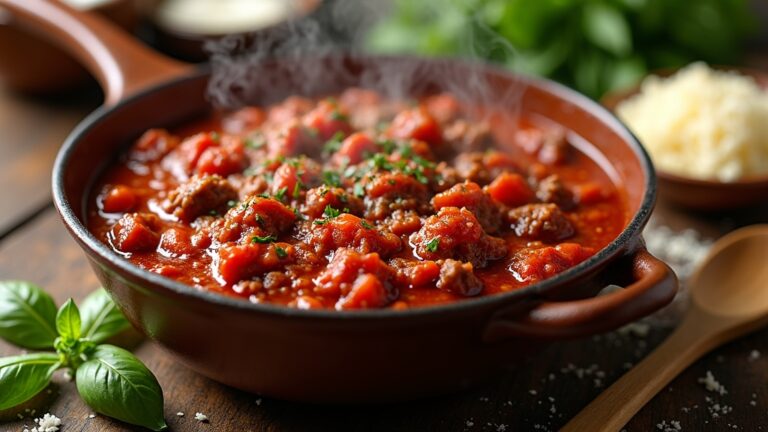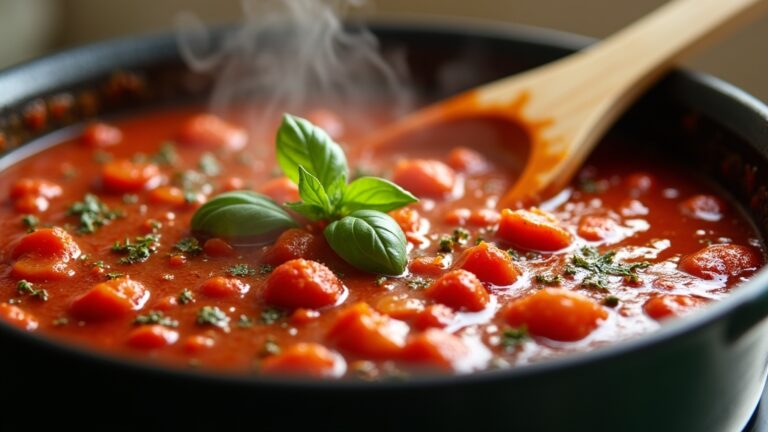Marinara Sauce Recipe
I love making marinara sauce with fresh tomatoes, garlic, and basil. First, I chop some garlic and sauté it, then add crushed tomatoes—San Marzano is my go-to for sweetness. I let it simmer for about 30 minutes to let the flavors meld, adding in torn basil leaves for that aromatic finish. Don’t forget a splash of olive oil for richness! There’s so much more to explore with marinara, from variations to creative serving ideas.
Contents
History
When I think about marinara sauce, I can’t help but marvel at its rich history, which dates back to the 18th century in Naples, Italy. This vibrant sauce, a cornerstone of Italian cuisine, reflects the culinary origins of a culture that values simplicity and quality ingredients. Initially crafted by local fishermen to accompany their fresh catches, marinara evolved from a humble blend of tomatoes, garlic, and herbs. Its popularity skyrocketed with the rise of pasta in Italy, transforming it into a beloved staple. Today, as I explore innovative twists on this classic, I appreciate how marinara continues to inspire chefs worldwide. It’s a reflection of how traditional flavors can adapt and thrive in contemporary kitchens while honoring their roots.
Recipe
Marinara sauce is a classic Italian tomato sauce that is not only versatile but also incredibly easy to make at home. This sauce is perfect for pasta dishes, as a base for pizza, or even as a dipping sauce for breadsticks. With its rich tomato flavor, aromatic herbs, and a hint of garlic, a homemade marinara sauce can elevate any meal and is a staple in many kitchens.
To make an authentic marinara sauce, you’ll want to use high-quality ingredients that highlight its simplicity. Fresh garlic, fragrant basil, and ripe tomatoes are key components that come together to create a rich and flavorful sauce. This recipe will guide you through the steps to create a delicious marinara sauce that can be stored for later use or enjoyed right away.
Ingredients:
- 2 tablespoons olive oil
- 4 cloves garlic, minced
- 1 can (28 ounces) whole peeled tomatoes
- 1 teaspoon salt
- 1 teaspoon sugar
- 1/2 teaspoon black pepper
- 1 teaspoon dried oregano
- 1/4 cup fresh basil, chopped (or 1 tablespoon dried basil)
- Red pepper flakes (optional, to taste)
In a large saucepan, heat the olive oil over medium heat. Add the minced garlic and sauté for about 1 minute, or until fragrant but not browned. Then, pour in the whole peeled tomatoes, crushing them with your hands or a spoon as you add them to the pan. Stir in the salt, sugar, black pepper, oregano, and red pepper flakes if using. Bring the sauce to a gentle simmer, reduce the heat to low, and let it cook uncovered for about 20-30 minutes, stirring occasionally. Finally, stir in the fresh basil just before serving.
When making marinara sauce, don’t hesitate to adjust the seasoning to your taste. If you prefer a sweeter sauce, add a bit more sugar; if you like a spicier kick, increase the amount of red pepper flakes. For a smoother texture, you can use an immersion blender to puree the sauce to your desired consistency. Marinara sauce can be stored in the refrigerator for up to a week or frozen for later use, making it a convenient option for busy weeknights. Enjoy experimenting with this recipe and make it your own!
Cooking Steps
Now that we have our ingredients ready, let’s jump into the cooking steps that bring this marinara sauce to life. I’ll start by chopping fresh garlic cloves, which will infuse our sauce with a wonderful aroma. As we add crushed tomatoes and let it simmer, you’ll see how simple ingredients transform into a rich, flavorful masterpiece.
Step 1. Chop Fresh Garlic Cloves
Chopping fresh garlic cloves brings a burst of flavor that can elevate your marinara sauce to new heights. The aroma is intoxicating, and the health benefits of garlic—boosting immunity and adding antioxidants—make it a must-use ingredient. To get started, choose firm, plump cloves; this guarantees maximum flavor. I often use a chef’s knife for chopping, which allows for precision. First, I crush the cloves gently with the blade, releasing their oils, then finely chop them using a rocking motion. This technique not only enhances their flavor but also guarantees even distribution in the sauce. Don’t skimp on the garlic—its robust taste will transform your marinara and impress anyone lucky enough to enjoy it!
Step 2. Add Crushed Tomatoes
Adding crushed tomatoes is the heart of creating a rich and flavorful marinara sauce. I love choosing high-quality crushed tomatoes, as they’re the foundation of this dish. Selecting the right tomato varieties can elevate your sauce; I often opt for San Marzano or Roma tomatoes for their sweetness and low acidity. Once I’ve prepped my garlic, I pour in the crushed tomatoes, watching their vibrant red color transform the pan. The texture becomes wonderfully thick and inviting, and the aroma fills my kitchen. Stirring gently, I let those luscious tomatoes mingle with the garlic, releasing their juices and creating a harmonious blend. This step is where the magic begins, and I can’t wait for the flavors to develop even further!
Step 3. Simmer for 30 Minutes
With the crushed tomatoes simmering in the pan, it’s time to let the flavors meld together. I love using various simmering techniques to guarantee a depth of flavor enhancement that takes my marinara sauce to the next level. As I watch the sauce bubble gently, I focus on these key elements:
- Stir occasionally to prevent sticking
- Adjust heat as necessary for a steady simmer
- Taste frequently to monitor flavor development
- Add a pinch of salt for balance
- Keep the lid slightly ajar to allow evaporation
After 30 minutes, the aromas will fill your kitchen, and the sauce will transform into a rich, velvety concoction. This is where the magic happens, creating a base that’s simply irresistible.
Step 4. Add Fresh Basil Leaves
As the sauce simmers and fills the air with its delicious aroma, I reach for a handful of fresh basil leaves to elevate the flavor profile. I love tearing the leaves rather than chopping them; this releases their essential oils, infusing the sauce with a vibrant, aromatic kick. Adding fresh basil not only enhances the taste but also brings a host of fresh basil benefits, like boosting antioxidants and aiding digestion. Each leaf contributes a unique layer to the basil flavor profile, balancing the acidity of the tomatoes with its sweet, peppery notes. I gently stir the torn leaves into the sauce, letting them wilt slightly, and watch as the magic unfolds, transforming my marinara into a truly innovative dish.
Step 5. Stir in Olive Oil
Next, I drizzle in a generous amount of extra virgin olive oil, watching it swirl gracefully into the simmering sauce. This isn’t just a finishing touch; it’s where the magic happens. Quality olive oil elevates the flavors, adding depth and richness while also imparting numerous olive oil benefits.
As I stir, I can’t help but savor the aroma. Here are some key advantages of incorporating this liquid gold:
- Enhances flavor complexity
- Provides healthy fats
- Boosts antioxidant content
- Improves heart health
- Adds a silky texture
This step not only enriches my marinara but also guarantees my dish is both delicious and nutritious. So, embrace that quality olive oil; your sauce deserves it!
Nutritional Guide
While I love savoring a rich marinara sauce, I also appreciate knowing how it fits into my diet. The health benefits of marinara are impressive, from antioxidants in tomatoes to the healthy fats in olive oil. Plus, I enjoy experimenting with ingredient variations to enhance both flavor and nutrition.
Here’s a quick nutritional guide for a standard serving:
| Nutrient | Amount per Serving |
|---|---|
| Calories | 70 |
| Total Fat | 4g |
| Carbohydrates | 10g |
| Protein | 2g |
| Fiber | 2g |
With these insights, I feel better equipped to enjoy my marinara sauce guilt-free, knowing it can complement a balanced diet while providing delicious flavors!
Final Thoughts
Although I relish the vibrant flavors of marinara sauce, the experience goes beyond just taste; it brings together wholesome ingredients that nourish my body. Crafting my own homemade variations of this classic sauce invites creativity into my kitchen, allowing me to experiment with flavors and textures. I love to explore unique sauce pairings that elevate my culinary creations, making every meal extraordinary.
Here are some ideas to inspire your marinara journey:
- Add roasted vegetables for depth.
- Incorporate fresh herbs like basil and oregano.
- Experiment with different types of tomatoes.
- Try a splash of red wine for richness.
- Serve with whole grain pasta or zucchini noodles for a twist.
Ultimately, marinara sauce is a canvas for innovation, and I can’t wait to see what you’ll create!
Frequently Asked Questions
Can I Use Canned Tomatoes Instead of Fresh for Marinara Sauce?
I’ve used canned tomatoes instead of fresh in my sauces, and they’re fantastic. They’re convenient, packed with flavor, and often more consistent. Just make sure to adjust your seasoning for the best results!
How Long Does Homemade Marinara Sauce Last in the Fridge?
Homemade marinara sauce lasts about five to seven days in the fridge. I always check for expiration signs like off smells or mold. For better storage, use airtight containers to keep it fresh longer!
Can I Freeze Marinara Sauce for Later Use?
Absolutely, I can freeze marinara sauce for later use! I recommend using airtight storage containers. For freezing tips, leave some space at the top to allow for expansion. Your future self will thank you!
What Herbs Pair Well With Marinara Sauce?
When I think about herbs that elevate dishes, basil’s benefits shine with its sweet aroma, while oregano’s origins bring a robust depth. Together, they create a vibrant harmony that transforms any meal into a culinary masterpiece.
Is Marinara Sauce Gluten-Free?
I’ve discovered that marinara sauce can be gluten-free, especially when using gluten-free ingredients like fresh tomatoes and herbs. If you’re looking for alternatives, consider using cauliflower or zucchini for innovative twists.
Conclusion
As I stir the rich, vibrant marinara sauce, I can’t help but think about how this beloved recipe dates back to the 18th century in Naples. Did you know that Americans consume over 200 million pounds of marinara sauce each year? It’s no wonder this sauce has woven itself into the fabric of our culinary traditions. So, whether you’re tossing it with pasta or using it as a pizza base, enjoy every delicious bite of your homemade masterpiece!





